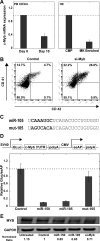MicroRNA screen of human embryonic stem cell differentiation reveals miR-105 as an enhancer of megakaryopoiesis from adult CD34+ cells
- PMID: 24446170
- PMCID: PMC3991759
- DOI: 10.1002/stem.1640
MicroRNA screen of human embryonic stem cell differentiation reveals miR-105 as an enhancer of megakaryopoiesis from adult CD34+ cells
Abstract
MicroRNAs (miRNAs) can control stem cell differentiation by targeting mRNAs. Using 96-well plate electroporation, we screened 466 human miRNA mimics by four-color flow cytometry to explore differentiation of common myeloid progenitors (CMP) derived from human embryonic stem cells (hESCs). The transfected cells were then cultured in a cytokine cocktail that supported multiple hematopoietic lineages. At 4-5 days post-transfection, flow cytometry of erythroid (CD235(+)CD41(-)), megakaryocyte (CD41(+)CD42(+)), and myeloid (CD18(+)CD235(-)) lineages revealed miR-105 as a novel enhancer of megakaryocyte production during in vitro primitive hematopoiesis. In hESC-derived CMPs, miR-105 caused a sixfold enhancement in megakaryocyte production. miR-513a, miR-571, and miR-195 were found to be less potent megakaryocyte enhancers. We confirmed the relevance of miR-105 in adult megakaryopoiesis by demonstrating increased megakaryocyte yield and megakaryocyte colony forming potential in human adult CD34(+) cells derived from peripheral blood. In addition, adult CD34(+) cells express endogenous miR-105 during megakaryocyte differentiation. siRNA knockdown of the hematopoietic transcription factor c-Myb caused a similar enhancement of megakaryocyte production as miR-105. Finally, a luciferase/c-Myb-3'UTR construct and Western blot analysis demonstrated that the hematopoietic transcription factor c-Myb mRNA was a target of miR-105. We report a novel hESC-based miR screening platform and demonstrate that miR-105 is an enhancer of megakaryopoiesis in both primitive and definitive hematopoiesis.
Keywords: Embryonic stem cells; Hematopoiesis; Megakaryocyte; miRNA.
© 2014 AlphaMed Press.
Figures






Similar articles
-
MYB controls erythroid versus megakaryocyte lineage fate decision through the miR-486-3p-mediated downregulation of MAF.Cell Death Differ. 2015 Dec;22(12):1906-21. doi: 10.1038/cdd.2015.30. Epub 2015 Apr 10. Cell Death Differ. 2015. PMID: 25857263 Free PMC article.
-
A common bipotent progenitor generates the erythroid and megakaryocyte lineages in embryonic stem cell-derived primitive hematopoiesis.Blood. 2009 Aug 20;114(8):1506-17. doi: 10.1182/blood-2008-09-178863. Epub 2009 May 28. Blood. 2009. PMID: 19478046
-
MicroRNA-mediated control of cell fate in megakaryocyte-erythrocyte progenitors.Dev Cell. 2008 Jun;14(6):843-53. doi: 10.1016/j.devcel.2008.03.012. Dev Cell. 2008. PMID: 18539114 Free PMC article.
-
Hematopoietic stem cell-independent hematopoiesis: emergence of erythroid, megakaryocyte, and myeloid potential in the mammalian embryo.FEBS Lett. 2016 Nov;590(22):3965-3974. doi: 10.1002/1873-3468.12459. Epub 2016 Oct 27. FEBS Lett. 2016. PMID: 27790707 Review.
-
[Research progress of proto-oncogene c-myb in megakaryocyte-erythroid hematopoiesis].Zhongguo Shi Yan Xue Ye Xue Za Zhi. 2012 Apr;20(2):518-22. Zhongguo Shi Yan Xue Ye Xue Za Zhi. 2012. PMID: 22541131 Review. Chinese.
Cited by
-
Insight into microRNAs' involvement in hematopoiesis: current standing point of findings.Stem Cell Res Ther. 2023 Oct 4;14(1):282. doi: 10.1186/s13287-023-03504-3. Stem Cell Res Ther. 2023. PMID: 37794439 Free PMC article. Review.
-
MicroRNA-mediated regulation of differentiation and trans-differentiation in stem cells.Adv Drug Deliv Rev. 2015 Jul 1;88:3-15. doi: 10.1016/j.addr.2015.04.004. Epub 2015 Apr 14. Adv Drug Deliv Rev. 2015. PMID: 25887992 Free PMC article. Review.
-
Biomanufacturing for clinically advanced cell therapies.Nat Biomed Eng. 2018 Jun;2(6):362-376. doi: 10.1038/s41551-018-0246-6. Epub 2018 Jun 11. Nat Biomed Eng. 2018. PMID: 31011198 Free PMC article. Review.
-
MicroRNAs in Control of Stem Cells in Normal and Malignant Hematopoiesis.Curr Stem Cell Rep. 2016 Sep;2(3):183-196. doi: 10.1007/s40778-016-0057-1. Epub 2016 Jul 1. Curr Stem Cell Rep. 2016. PMID: 27547713 Free PMC article.
-
Electroporation Knows No Boundaries: The Use of Electrostimulation for siRNA Delivery in Cells and Tissues.J Biomol Screen. 2015 Sep;20(8):932-42. doi: 10.1177/1087057115579638. Epub 2015 Apr 7. J Biomol Screen. 2015. PMID: 25851034 Free PMC article. Review.
References
Publication types
MeSH terms
Substances
Grants and funding
LinkOut - more resources
Full Text Sources
Other Literature Sources

